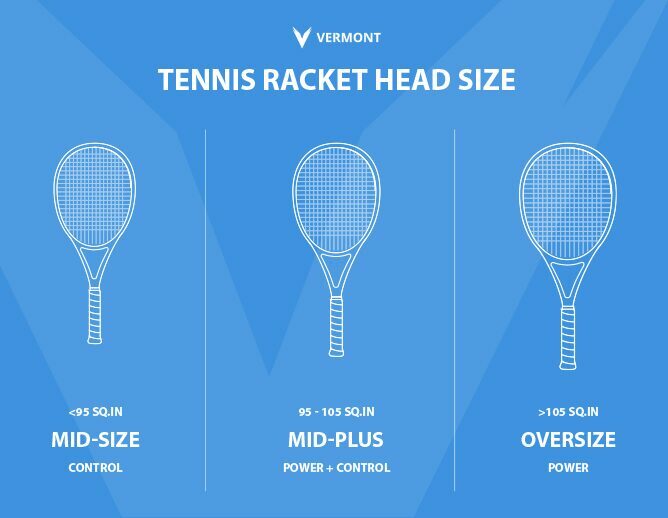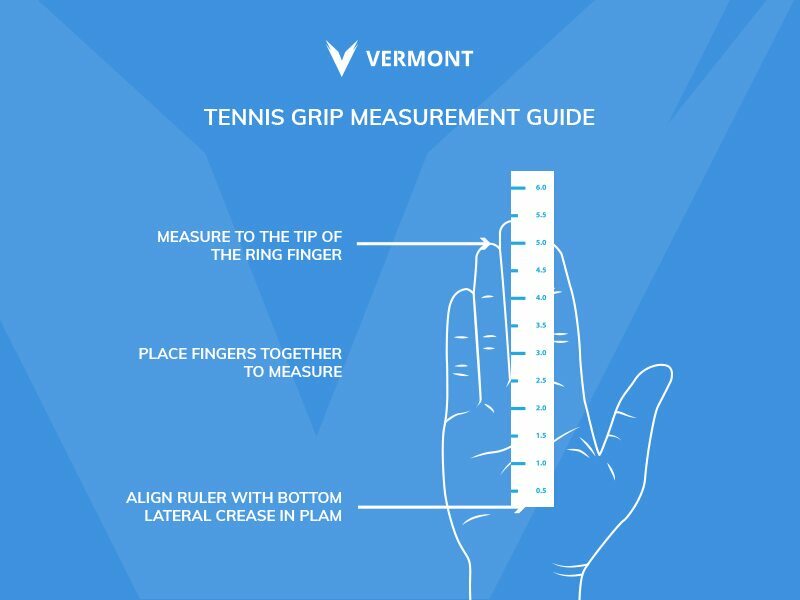
When it comes to variables and factors that influence tennis performance, few are as crucial as getting the right tennis racket.
If you are looking to buy a new tennis racket, then you’ll want to be sure that you purchase one which is the correct size. In this tennis racket size guide, we will break down how to determine the perfect size racket for yourself or a loved one. This will include a look at the different tennis head dimensions available, the different tennis grips and how to choose the right length of tennis racket for junior players.
The ITF has a number of rules and restrictions regarding the dimensions of tennis rackets that are allowed to be used in regulated matches.
Tennis rackets must:
The image below displays the dimensions of a typical “Mid-Plus” senior tennis racket:

Whilst we’ve covered the ITF’s maximum dimensions for a tennis racket above, you’ll need to consider various factors when determining what size tennis racket is likely to perform best for you. It’s important to consider both the head size of the racket and the length of the grip or handle.
Below, we will take a look at the different head sizes available and how they affect performance. We’ll also cover tennis racket grip sizes, and how to measure yourself to find the perfect grip length & width.
Measuring the size of a tennis racket’s head is relatively simple to do yourself, with a tape measure or ruler.
This will give you the total surface area of the tennis racket’s head.


Finding the optimal tennis racket head size is more a question of playing style, than age or physical size. Generally speaking, the bigger a tennis head, the more power a player will be able to generate. Beginners or smaller players will often opt for a racket with a relatively large head so that they can hit the ball more easily, and generate power without having to put full force into each shot.
Smaller racket heads tend to provide more control. For this reason, intermediate and advanced players will tend to opt for a racket with a relatively small head as they are able to place shots with greater accuracy.
The size of the tennis racket head will also influence the size of the racket’s “sweet spot”. The sweet spot is essentially the area of the racket, near the centre, which provides the optimal power and control and the least vibration down the handle when the ball is hit.
A racket with a larger head size will tend to have a larger sweet spot, which again is a big advantage for beginners who may not be able to make contact with the ball as accurately as advanced players.
One disadvantage of tennis rackets with larger head sizes is that they tend to be more awkward to handle. When using a racket with a large head, many players will find it more difficult to change grips and generally react at speed, compared to using a racket with a smaller head.
If you are a beginner, playing against another beginner, or working with a coach, the chances are the ball won’t be travelling at particularly fast speeds towards you. With this in mind, a racket with a relatively large head, shouldn’t prove a disadvantage.
Tennis racket head sizes are usually broken down into three categories, as shown in the image below:

It’s important that children use a tennis racket that is the correct size for them to maximise enjoyment and ensure that they don’t become frustrated with a racket that is too small or too large.
Whilst racket head sizes don’t vary a great deal, the length of different junior and senior tennis rackets does. Choosing the correct size tennis racket, generally comes down to purchasing a racket that’s the correct length.
Children grow at different rates, but as a general guideline, the table below outlines the correct tennis racket length for each age group:
| Tennis Racket Size by Age | |
|---|---|
| Age | Racket Length |
| 4 and below | 19 inches |
| 4-5 | 19-21 inches |
| 6-8 | 21-23 inches |
| 9-10 | 23-25 inches |
| 12+ | 25-27 inches |
Children under the age of 4, are often introduced to the game of tennis with a plastic tennis racket and a foam ball. Foam balls are larger, slower and softer than regular tennis balls, making them easier for youngsters to hit. They’re also less likely to encounter the issue of the tennis balls constantly bouncing above head height - which can happen with standard tennis balls.
Children then progress into mini tennis. Designed specifically to introduce children aged 4-10 to a modified version of the game of tennis, mini-tennis uses smaller courts, nets, rackets and balls that bounce lower & slower. Mini-tennis allows children to participate without the frustration that can come when attempting to start off with full-size equipment which they rarely have the physical strength to use. With standard tennis balls often bouncing above head height of young children, the modified balls also make a huge difference, making the game more enjoyable for participants.
You can read more about mini tennis and the 3 separate stages of development in our comprehensive mini tennis guide.
When choosing a tennis racket, it’s vital to get the correct grip size. If a grip is too big, it can be challenging to hold a racket and your grip will fatigue quickly. A grip that is too large can also limit the movement of the wrist and lead to injuries including tennis elbow.
A grip that is too small can prove equally difficult to hold and may even rotate in your hand when hitting the ball, making it difficult to control the accuracy of your shots. Inappropriately small grip size can also lead to you dropping the tennis racket, especially when perspiration sets in.
Determining what tennis racket grip size is likely to work best for you is actually very straightforward. You can find the correct grip or handle diameter by measuring your hand using a ruler or tape measure.
The easiest way to measure your hand and find your tennis grip size, is to use a ruler. The steps involved in this method are outlined in the image and text below:

If you are between sizes, it’s usually best to opt for a smaller size if you like to add topspin/backspin to your shots, or a larger size if you tend to hit flatter groundstrokes.
Some players even choose racket grip sizes that would normally be deemed too large or too small because it suits their game. For example, players opt for a grip that is a “size too small” because a smaller handle can be used to generate more spin.
If you are buying a tennis racket online, then the product listing should include the grip size. If you want to check the size of your current tennis racket, it is normally printed on the base of the handle.
Rackets made in Europe may have numbers, rather than a size in mm or inches printed on the base.
| Tennis Racket Grip Sizes | ||
|---|---|---|
| Grip Size in mm | US Grip size (inches) | European Grip Size |
| 102mm | 4 inches | 0 (L0 or G0) |
| 105mm | 4 1/8 inches | 1 (L1 or G1) |
| 108mm | 4 1/4 inches | 2 (L2 or G2) |
| 111mm | 4 3/8 inches | 3 (L3 or G3) |
| 114mm | 4 1/2 inches | 4 (L4 or G4) |
| 118mm | 4 5/8 inches | 5 (L5 or G5) |
Another consideration to bear in mind when choosing a tennis racket is the weight. Whilst there are no rules regarding how heavy a racket should be, playing style and level of strength/endurance will usually dictate which weight of racket a player opts for.
The table below categorises tennis rackets by weight:
| Tennis Racket Weights | ||
|---|---|---|
| Weight | Category | Benefits |
| < 290g | Light | Control & manoeuvrability |
| 290-310g | Average | Power & control |
| > 310g | Heavy | Power |
Experienced tennis players tend to choose a racket weight, based on their playing style. A heavy tennis racket will tend to produce more power than a lighter one. However, a heavier racket is more difficult to handle and manoeuvre, when for example, changing grips and setting up shots. A heavier tennis racket can also be difficult to use for junior players and will prove more challenging to use in longer matches when endurance becomes a key factor.
Lighter rackets tend to be easier and quicker to swing for groundstrokes, or position for volleys. They’re also easier to handle when looking to change grip or switch up your approach to a shot. Lighter rackets (less than 290g) will tend to have less power than rackets that weigh over 300g.
For most people, it is usually best to opt for a medium or average-weight tennis racket between 290-310g.


Tennis racket strings typically weigh between 12 and 20g so they only make up a small part of the overall weight of a tennis racket. The amount that they weigh can vary according to the material used. For example, polyester strings typically weigh more than synthetic multifilaments.
At Net World Sports we sell a comprehensive range of tennis rackets for junior and senior players. From Mini Tennis Rackets to our pièce de résistance - the Vermont Archon Tennis Racket. Offering a professional performance, the Archon racket is manufactured using a VPG Elite Tek Graphite Construction. Providing both power and control, the racket is available in a range of grip sizes.
We also stock a selection of tennis training aids and court equipment including nets, carts and hoppers. Having featured in several Grand Slam tennis tournaments including Wimbledon, our tennis court equipment is second to none!